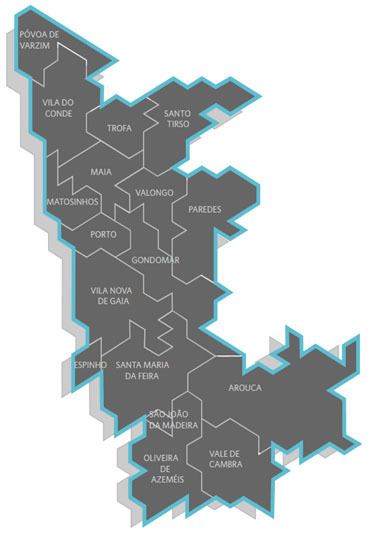Website A.M. Porto Population 2.863 million (2011) | Area 2,040 km² | |
 | ||
Municipalities Arouca, Espinho, Gondomar, Maia, Matosinhos, Oliveira de Azeméis, Paredes, Porto, Póvoa de Varzim, Santa Maria da Feira, Santo Tirso, São João da Madeira, Trofa, Vale de Cambra, Valongo, Vila Nova de Gaia and Vila do Conde. Points of interest Palácio da Bolsa, Dom Luís I Bridge, Church of São Francisco, Casa da Música, Clérigos Church | ||
Porto Metropolitan Area (Portuguese: Área Metropolitana do Porto) is a metropolitan area in coastal northern Portugal which covers 17 municipalities, including the City of Porto, making up the second biggest urban area in the country. Porto Metropolitan Area was created in 1991. It is a union of metropolitan municipalities, comprising both former Grande Porto Subregion (9 municipalities) and Entre Douro e Vouga Subregion (5 municipalities) which were two NUTS III subdivisions as well as parts of Ave Subregion and Tâmega Subregion. The population in 2011 was 2,762,524 in an area of 2,040.31 km². Currently the most populous municipality is Vila Nova de Gaia, which is located on the South side of the Douro River, on the opposite side of Porto.
Contents
History
The original Metropolitan Area of Porto was constituted by nine municipalities: Porto (the capital), Espinho, Gondomar, Maia, Matosinhos, Póvoa de Varzim, Vila Nova de Gaia, Valongo, and Vila do Conde. The process of enlargement:
Government
The metropolitan area is governed by the Junta Metropolitana do Porto (JMP), headquartered in Avenida dos Aliados, in downtown Porto under the presidency of Hermínio Loureiro, also the mayor of Oliveira de Azeméis municipality, since the Municipal Elections held in 2013, when he succeeded Rui Rio, mayor of Porto.
The Assembleia Metropolitana do Porto (Porto Metropolitan Assembly) is composed of 43 MPs, the PSD party has 20 seats, the PS 16, the CDS 3, CDU 3 and the BE, one.
Although the government has halted the intention of creating new metropolitan areas and urban communities, it is keen to ensure greater autonomy to Porto and Lisbon metropolitan areas.
Urban areas and agglomeration
Greater Porto is the second largest metropolitan area of Portugal, with about 1.7 million people. It groups the larger Porto Urban Area, the second largest in the country, assembled by the municipalities of Porto, Matosinhos, Vila Nova de Gaia, Gondomar, Valongo and Maia. A smaller urban area of Póvoa de Varzim and Vila do Conde, which ranks as the six largest in continental Portugal. The new regional spatial planning program (PROT-Norte), recognizes both urban areas and engages in their development.
There are some intentions to merge the municipalities of Porto with Gaia and Matosinhos into a single and greater municipality, and there is an ongoing civil requisition for that objective. The government also started to discuss the merging of some municipalities due to conurbations, but gave up. There is a similar idea for the conurbation of Póvoa de Varzim and Vila do Conde, and both municipalities have decided to work as if both are the same city, cooperating in health, education, transports and other areas. Several municipalities of the metropolitan area also moved closer, thus becoming a cohesive group.
The urban-metropolitan agglomeration known as Northern-western Urban-Metropolitan Agglomeration or Porto Metropolitan Arch is a regional urban system of polycentric nature that stretches far beyond the metropolitan borders, and includes circa 3 million people, which takes in other main urban areas such as Braga and Guimarães, the third and eighth largest cities (as defined by urban areas) of Portugal. One should also note that the entire region of Northern-western Portugal is, in fact, a single agglomeration, linking Porto and Braga to Vigo in Galicia Spain.
Transportation
The Metropolitan area is keen to develop its transportation network. Porto Metro is a Rapid transit system that links the municipalities of Porto, Vila Nova de Gaia, Matosinhos, Gondomar, Maia, Vila do Conde and Póvoa de Varzim.
The Porto/ Francisco de Sá Carneiro Airport / Pedras Rubras (OPO), between the municipalities of Maia, Matosinhos,and Vila do Conde, is also one of its greater investments. It was transformed from an old and obsolete airport to a modern transportation centre, linked to Porto Metro. The JMP is also trying to pressure the government to add a TGV line to link Vigo in Galicia to Porto Airport in order to make Porto the air traffic centre of the North-Western Iberian Peninsula and to tighten its historical ties with that Spanish province.
Greater Porto is served by a great number of Motorways linking the main central areas of the metropolitan region and the region with other main Portuguese cities (cidades portuguesas). Main Harbour: Leixões (Matosinhos). Motorways:
